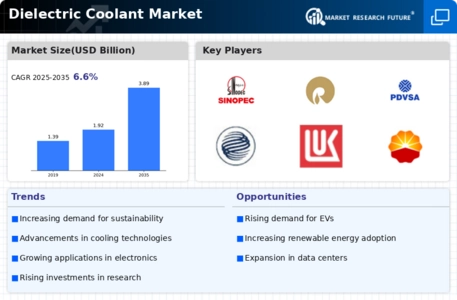Rising Demand for Energy Efficiency
The increasing emphasis on energy efficiency across various sectors appears to be a primary driver for the Dielectric Coolant Market. As industries strive to reduce energy consumption and operational costs, the demand for efficient cooling solutions has surged. Dielectric coolants, known for their superior thermal management properties, are increasingly utilized in applications such as transformers and power electronics. According to recent data, the market for dielectric coolants is projected to grow at a compound annual growth rate of approximately 6% over the next few years. This trend indicates a robust shift towards adopting advanced cooling technologies that enhance energy efficiency, thereby propelling the Dielectric Coolant Market forward.
Expansion of Renewable Energy Sources
The expansion of renewable energy sources, particularly solar and wind, is likely to drive the Dielectric Coolant Market significantly. As the world transitions towards sustainable energy solutions, the need for efficient cooling systems in renewable energy applications becomes paramount. Dielectric coolants are essential in managing the heat generated in photovoltaic systems and wind turbines, ensuring optimal performance and longevity. The increasing installation of renewable energy systems is expected to create a substantial demand for dielectric coolants, with estimates suggesting that the market could witness a growth rate of around 7% in the coming years. This trend underscores the critical role of dielectric coolants in supporting the global shift towards renewable energy.
Increasing Adoption in Electric Vehicles
The increasing adoption of electric vehicles (EVs) is poised to significantly influence the Dielectric Coolant Market. As the automotive sector shifts towards electrification, the need for effective thermal management solutions becomes critical. Dielectric coolants are essential in battery cooling systems, ensuring optimal performance and safety. The EV market is expected to grow exponentially, with estimates suggesting that the number of electric vehicles on the road could reach over 30 million by 2030. This surge in EV adoption is likely to create a substantial demand for dielectric coolants, thereby propelling the market forward. The integration of dielectric coolants in EV applications underscores their importance in the evolving automotive landscape.
Technological Innovations in Cooling Solutions
Technological innovations in cooling solutions are transforming the Dielectric Coolant Market. The development of advanced dielectric fluids with enhanced thermal properties and environmental compatibility is gaining traction. Innovations such as nanofluids and bio-based dielectric coolants are emerging, offering improved performance and sustainability. These advancements not only cater to the growing demand for efficient cooling systems but also align with regulatory standards aimed at reducing environmental impact. The market for these innovative cooling solutions is anticipated to expand, with projections indicating a potential increase of 5% in market share over the next few years. This evolution in technology is likely to redefine the landscape of the Dielectric Coolant Market.
Regulatory Support for Environmentally Friendly Solutions
Regulatory support for environmentally friendly solutions is a significant driver for the Dielectric Coolant Market. Governments worldwide are implementing stringent regulations aimed at reducing greenhouse gas emissions and promoting sustainable practices. This regulatory landscape encourages industries to adopt eco-friendly cooling solutions, including dielectric coolants that are less harmful to the environment. The market is witnessing a shift towards biodegradable and non-toxic dielectric fluids, which aligns with these regulatory initiatives. As industries comply with environmental standards, the demand for such dielectric coolants is expected to rise, potentially increasing market growth by approximately 4% in the coming years. This regulatory support highlights the critical role of dielectric coolants in fostering sustainable industrial practices.


















Leave a Comment